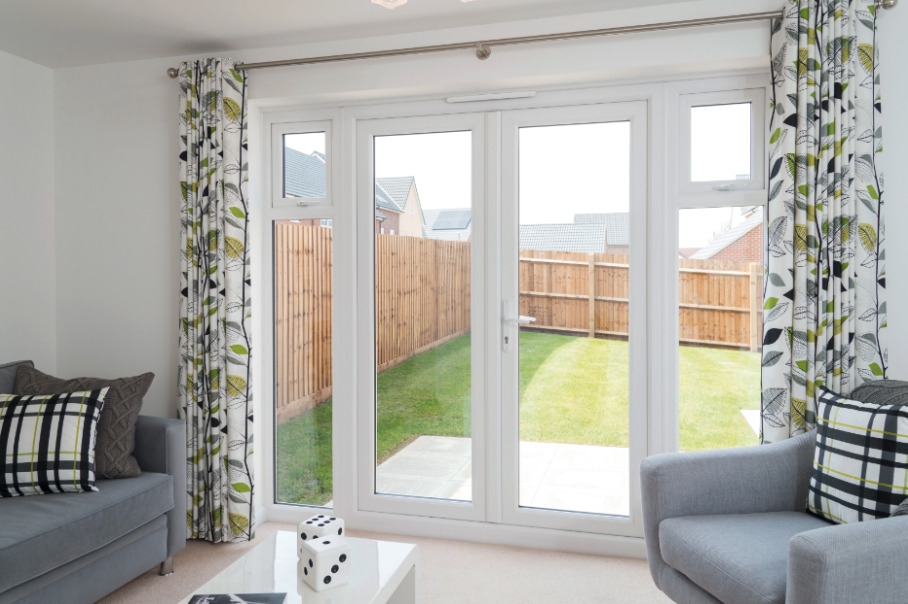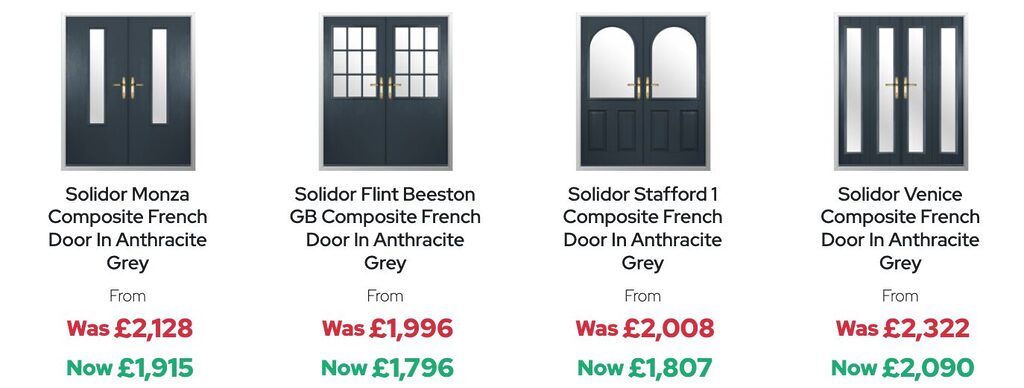Last Updated on 17 July 2024 by Tia Ellahi
Adjusting a uPVC double-glazed door depends on the type of hinge it has. The most common types are butt hinges, flag hinges, and T-hinges, each requiring a specific adjustment method.
Double-glazed doors or French doors are a popular choice for many homeowners due to their energy efficiency and security features. However, over time, these doors may experience issues such as misalignment or warping, leading to problems like drafts and difficulty in closing.
The good news is that you can often resolve these issues by adjusting the hinges on your uPVC door. In this comprehensive guide, we’ll take you through the step-by-step process of adjusting double-glazed doors to ensure proper alignment and functionality.

If you’re looking for a set of French doors that are beautifully engineered and meticulously designed, we’d definitely recommend taking a look at our Reynaers French Doors collection.
How to check if your door is out of alignment or warped
Before delving into the adjustment process, it’s crucial to diagnose the problem correctly. Here’s how you can determine whether your double-glazed door is out of alignment or warped:
What causes double-glazed doors to drop?
Misalignment or dropping of double-glazed doors can occur due to various factors, including:
- Gravity: Over time, doors may sag downward under the influence of gravity.
- Heat: Extreme heat can cause materials to expand and contract, affecting door alignment.
- Humidity: High humidity levels can lead to warping, impacting door operation.
Understanding the root causes of the issue will help you address it effectively.
What type of hinge does my uPVC door have?
Different types of hinges require specific adjustment techniques. There are three common types of hinges used on uPVC doors:
Butt hinges

Butt hinges are typically found on older uPVC doors and may offer limited adjustment options. If your door has butt hinges and requires adjustment, read on to learn more.
Flag hinges

Flag hinges are commonly used in modern uPVC doors and provide more flexibility for adjustments. We’ll walk you through the steps of adjusting flag hinges to achieve proper door alignment.
T-Hinges

T-hinges have their unique adjustment capabilities. Discover how to make height and lateral adjustments when dealing with doors equipped with T-hinges.
How to adjust uPVC door hinges
Now that you’ve identified your hinge type, it’s time to explore the adjustment process. We’ll provide detailed instructions for adjusting:
How to adjust Butt hinges on a uPVC door
While some butt hinges remain non-adjustable, others offer lateral adjustment capabilities. To determine if your butt hinge is adjustable, examine its side, where you’ll find a Philips head screw.
Before attempting to turn this screw, it’s essential to check for the presence of a small grub screw. This grub screw functions as a lock, securing the hinge in place to prevent door movement. Keep in mind that not all butt hinges include a grub screw, but loosening it is necessary if present for any adjustments to be made.
How to adjust Flag hinges on a uPVC door
Flag hinges offer three distinct adjustments:
- Height: To adjust the height of a door with flag hinges, locate the height adjuster typically situated at the bottom of the hinge. This adjuster may or may not be covered by a plastic plug. Utilise an Allen wrench, typically a 5 mm size (though this may vary by manufacturer), to make height adjustments.
- Lateral: Flag hinges also allow for lateral adjustments. The lateral adjuster may be concealed behind a plastic cover, often referred to as the “flag,” or hidden behind a small plug on the side farthest from the door frame. To access it, remove one or two Philips screws securing the plastic cover, visible when the door is open. Once the cover is removed, you’ll find the Allen bolt on the side. Turning it clockwise moves the door toward the hinge, while counterclockwise rotation moves it away from the door hinge.
- Compression: To adjust the compression of the door, locate the compression adjuster, typically positioned at the top of the flag hinge, hidden beneath a plastic plug. Gently remove this plug using a flathead screwdriver to reveal the Allen bolt beneath. Tightening this bolt brings the door closer to the door frame, creating a tighter seal.

How to adjust T-hinges on a uPVC door
T-hinges offer two adjustment options:
- Compression: You can adjust the top and bottom compressors to either bring the door closer to or move it away from the door jamb, thereby tightening or loosening the seal.
- Lateral: Similar to flag hinges, the lateral adjustment mechanism is concealed behind a plastic cover, which can be removed using a similar method.
FAQs about adjusting double-glazed doors
How often should I check and adjust my double-glazed doors?
The frequency of checking and adjusting your double-glazed doors depends on various factors such as usage, climate, and the quality of installation. As a general guideline, it’s advisable to inspect your doors annually for signs of misalignment, drafts, or wear and tear. Adjustments may be needed if you notice any issues.
Can I adjust double-glazed doors without professional help?
Yes, many adjustments for double-glazed doors can be performed without professional assistance. Common adjustments like those for hinges and latches are often manageable with basic tools and guidance. However, if you’re unsure or face complex issues, it’s best to consult a professional to ensure the correct adjustments are made.
What tools do I need for adjusting uPVC door hinges?
To adjust uPVC door hinges, you may need the following tools:
- Allen wrenches (hex keys)
- Flat head screwdriver
- Philips head screwdriver
These tools are typically used for adjusting different types of hinges on uPVC doors.
Are there any common mistakes to avoid during the adjustment process?
While adjusting uPVC door hinges, avoid these common mistakes:
- Over-tightening screws, which can lead to damage or misalignment.
- Not checking for hidden screws or locking mechanisms.
- Ignoring the manufacturer’s guidelines or warranty terms related to adjustments.
Precision and patience are key to successful adjustments.
What to do if I adjust my uPVC door hinges and it doesn’t work?
If adjustments fail to resolve the issues with your double-glazed doors, consider the following options:
- Hinge Replacement: If the hinges are worn or damaged, replacing them with new ones can often solve alignment problems.
- Professional Assistance: Seek help from a door installation or repair professional who can diagnose and address the issue correctly.
- Full Door Replacement: In cases of extensive damage or old doors, replacing the entire door may be the most effective solution for long-term performance and energy efficiency.
Always consult with a professional for expert advice if adjustments prove unsuccessful.

